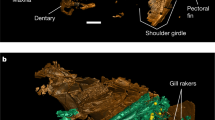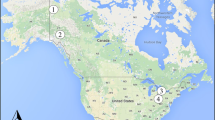Abstract
Insular ecosystems have been subjected to severe hardship during the last millennia. Large numbers of insular bird species have undergone local disappearances and full extinctions, and a high number of insular birds are currently categorised as endangered species. In most of these cases, extinction—or endangerment—is in direct relation to the arrival of ‘aboriginal’ and/or imperialist waves of human settlement. Insular bird extinction events have been documented to have occurred at times corresponding to aboriginal settlement at many archipelagos and isolated islands, such as the Hawaiian Islands, New Zealand, the West Indies or the tropical Pacific Islands. However, no bird extinctions could be attributed to the first settlers of the Canary Islands—until now. The first accelerator mass spectrometer radiocarbon (14C) dating of collagen from a bone of the Dune Shearwater Puffinus holeae (3395 ± 30 year BP), an extinct bird from the Canary Islands, indicates a late Holocene extinction event. This relatively recent date, together with some features of this bird (large body size, breeding areas situated at very accessible places) and the absence of its bones from the entire archaeological record suggests that the extinction occurred close to the time that the first human settlement occurred on the islands.


Similar content being viewed by others
References
Alcover JA, Ramis D, Coll J, Trias M (2001) Bases per al coneixement del contacte entre els primers colonitzadors humans I la naturalesa de les Balears. Endins 24:5–57
Alcover JA, Rando JC, García-Talavera F, Hutterer R, Michaux J, Trias M, Navarro JF (2009) A reappraisal of the stratigraphy of Cueva del Llano (Fuerteventura) and the chronology of the House Mouse (Mus musculus) introduction into the Canary Islands. Palaeogeogr Palaeoclimatol Palaeoecol 177:184–190
Atoche P, Paz JA, MªA Ramírez, Ortiz ME (1995) Evidencias arqueológicas del mundo romano en Lanzarote (Islas Canarias). Cabildo de Lanzarote, Arrecife
Bover P, Alcover JA (2003) Understanding Late Quaternary extinctions: the case of Myotragus balearicus Bate 1909. J Biogeogr 30:771–781
Boyer AG (2008) Extinction patterns in the avifauna of the Hawaiian islands. Divers Distrib 14:509–517
Bronk Ramsey C (2006) OxCal Program v4.0. Available at: http://c14.arch.ox.ac.uk/
Castellano JM, Macías FJ (1997) Historia de Canarias. Centro de la Cultura Popular Canaria, Arafo
Galván B, Hernández C, Velasco J, Alberto V, Borges E, Barro A, Larraz A (1999) Orígenes de Buenavista del Norte: de los primeros pobladores a los inicios de la colonización europea. Ayuntamiento de Buenavista del Norte, Santa Cruz de Tenerife
Hutterer R, López-Martínez N, Michaux J (1988) A New rodent from quaternary deposits of the Canary islands and its relationships with neogene and recent murids of Europe and Africa. Palaeovertebrata 18:241–262
IUCN (2007) Red list of threatened species. Available at: http://www.iucnredlist.org/
James HF (1995) Prehistoric extinctions and ecological changes on oceanic islands. Ecol Stud 115:87–102
Martí R, Del Moral JC (eds) (2003) Atlas de las aves reproductoras de España. Dirección General de Conservación de la Naturaleza. Sociedad Española de Ornitología, Madrid
Martín A, Lorenzo JA (2001) Aves del Archipiélago Canario. Lemus Editor, La Laguna
McMinn M, Jaume D, Alcover JA (1990) Puffinus olsoni n.sp.: nova espècie de baldritja recentment extinguida provinent de depòsits espeleològics de Fuerteventura i Lanzarote (Illes Canàries, Atlàntic Oriental). Endins 16:63–71
Michaux J, Hutterer R, López-Martínez N (1991) New fossil faunas from Fuerteventura, Canary Islands: Evidence for a Pleistocene age of endemic rodents and shrews. C R Acad Sci Paris 312:801–806
Mourer-Chauviré C, Antunes MT (2000) L’Avifaune pléistocène et holocène de Gruta da Figueira Brava (Arrábida, Portugal). Mem Acad Ciénc Lisboa 38:129–159
Navarro JF, Martín E, Rodríguez A (1990) Las primeras etapas del programa de excavaciones en las Cuevas de San Juan y su aportación a la diacronía de la Prehistoria de Canarias. Invest Arqueológ Canarias II:189–201
Olson SL, James HF (1982) Fossil birds from the Hawaiian Islands: evidence for a wholesale extinction by man before Western contact. Science 217:633–635
Quammen D (1996) The song of the dodo: island biogeography in an age of extinctions. Pimlico, London
Ramis D, Alcover JA, Coll J, Trias M (2002) The chronology of the first settlement of the Balearic Islands. J Medit Archaeol 15:3–24
Rando JC (2003) Protagonistas de una catástrofe silenciosa: los vertebrados extintos de Canarias. El Indiferente 14:4–15
Rando JC, Alcover JA (2008) Evidence for a second western Palaearctic seabird extinction during the last Millennium: the Lava Shearwater Puffinus olsoni. Ibis 150:188–192
Rando JC, Perera MA (1994) Primeros datos de ornitofagia entre los aborígenes de Fuerteventura (Islas Canarias). Archaeofauna 3:13–19
Rando JC, Alcover JA, Navarro JF, García-Talavera F, Hutterer R, Michaux J (2008) Chronology and causes of the extinction of the Lava Mouse, Malpaisomys insularis (Rodentia: Muridae) from the Canary Islands. Quat Res 70:141–148
Sánchez Marco A (2003) Nuevo hallazgo de aves marinas del Pleistoceno de Fuerteventura (Islas Canarias). Coloq Paleontol 1:627–636
Snow DW, Perrins CM (1998) The birds of the Western Palearctic, vol. 1: non-passerines. Oxford University Press, Oxford
Steadman D (2006) Extinction and biogeography of tropical Pacific birds. University of Chicago Press, London
Steadman D, Pregill G, Burley D (2002) Rapid prehistoric extinction of iguanas and birds in Polynesia. Proc Natl Acad Sci USA 99:3673–3677
Stuiver M, Braziunas TF (1993) Sun, ocean climate and atmospheric14CO2: an evaluation of causal relationships. Holocene 3:289–305
Tuggle HD, Spriggs M (2000) The age of the Bellows dune site O18, Oahu, Hawaii, and the antiquity of Hawaiian colonization. Asian Perspect 39:165–188
Walker CA, Wragg GM, Harrison CJO (1990) A new shearwater from the Pleistocene of the Canary Islands and its bearing on the evolution of certain Puffinus shearwaters. Hist Biol 3:203–224
Worthy TH, Holdaway RH (2002) Prehistoric life of New Zealand. The lost world of the Moa. Indiana University Press, Indiana
Zilhâo J (2001) Radiocarbon evidence for maritime pioneer colonization at the origins of farming in west Mediterranean Europe. Proc Natl Acad Sci USA 98:14180–14185
Acknowledgements
We thank Área de Patrimonio del Cabildo de Fuerteventura, especially Nacho Hernández, and F. García-Talavera, J.F. Navarro, M. Trias and J. Michaux for information and help in the field work, and Mark van Strydonck and Mathieu Boudin for their help with the radiocarbon dating. This work was supported by Spanish DGICYT Research Project CGL2007-62047/BTE (Cronología y causas de las extinciones de vertebrados autóctonos en Canarias y Baleares: un análisis comparativo. II). We are very grateful to Damià Jaume (Palma de Mallorca) and Eamon Manning (Dublin) for reviewing the English. Finally, the comments of two anonymous reviewers contributed to the improvement of the paper. The authors declare that all of the work performed during this project complies with current Spanish laws.
Author information
Authors and Affiliations
Corresponding author
Additional information
Communicated by P. H. Becker.
Rights and permissions
About this article
Cite this article
Rando, J.C., Alcover, J.A. On the extinction of the Dune Shearwater (Puffinus holeae) from the Canary Islands. J Ornithol 151, 365–369 (2010). https://doi.org/10.1007/s10336-009-0463-6
Received:
Revised:
Accepted:
Published:
Issue Date:
DOI: https://doi.org/10.1007/s10336-009-0463-6




